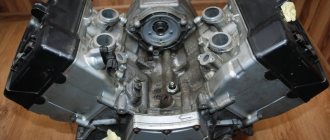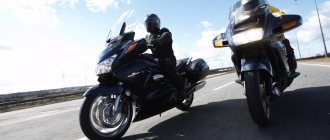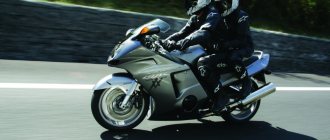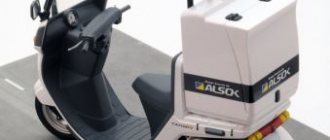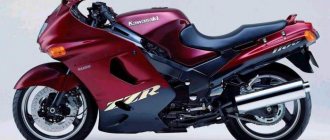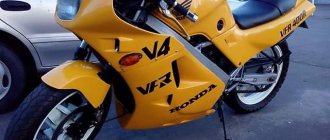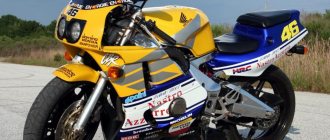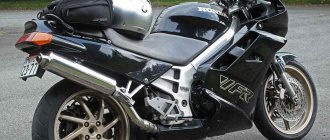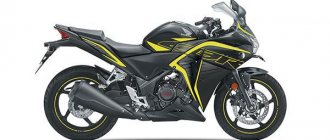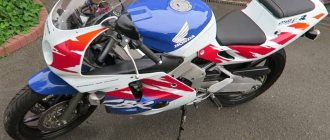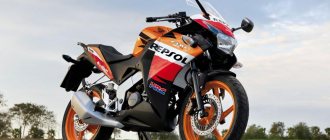What makes a successful vehicle model? Motor? Suspension? Duration of release? No. Even with all the advantages, the model may seem like a failure.
But if the traffic police like it, its success is guaranteed.
This is exactly what the Honda ST 1100 Pan European became. Having appeared in 1990, the police in England and America liked it so much that two years later the developers presented a special model - Honda ST 1100 Police . A different color, a more powerful engine and a different instrument panel distinguished the policeman.
Prototype of the ST 1100 model
At the same time, the prototype for it was the concern’s model about which legends were made - the Honda Gold Wing.
The legendary “Golda” has been produced for more than 40 years and during this time has acquired a huge army of fans.
Initially planned as a cheaper analogue of the “Wing”, Pan European has become a completely new solution that is in demand, despite the fact that it is outdated, archaic, etc.
A clear indication of its quality is the lesser success of the newer Pan European 1300.
ST in the name Sport Touring is a subtle hint that the model is ideal for long-distance driving and long years in the owner’s garage. This confirms the presence of side cases, a high windshield and a huge gas tank already included in the factory configuration.
Tourist option – Honda ST 1100 Pan European.
Police version - Honda ST 1100 Police.
Pan European or pannochka, as the owners called her, lived on the assembly line until 2002 .
The police counterpart outlived her by a year.
Modifications
As happened with the previous model, in 2005 the ST 1300 Pan European Police modification appeared - a model for traffic police.
Honda ST-1300 Pan European Police - police version.
However, it was not as brightly colored as those previously produced, so it was widely used not only by authorities, but also by many simple municipal services. No other developments were made.
In 2013, work begins on the STX 1300, the future successor.
and competitors
The motorcycle was not left without competitors either. They didn’t bother with the police version, but for the tourist they provided:
- Yamaxa offered the FJR 1300 model, the updated FJ 1200. Production started in 2001, completed in 2016.
- Kawasaki came out with a slightly larger model - the 1400 GTR. Due to the launch of it already in 2007, he studied the problems of competitors, and continues to assemble it today.
Specifications
An interesting feature was the timing drive solution. A gear drive was added in parallel to the standard belt solution.
The developers explained that if the belt breaks, you can drive further. The gears are designed to operate independently. Otherwise, the bike did not receive any special solutions. 4-stroke engine was installed on it .
The engine is deployed across the frame, and the clutch is located in the front part.
The arrangement of the pistons is V-shaped , the angle between them is 90 0. It gave:
engine, the following parameters:
- working volume - 1085 cm3;
- power - 100 (98) hp;
- number of valves - 16;
- cylinders - 4;
- cooling - liquid;
- fuel supply - carburetor (Keihin, 32 mm);
- ignition - transistor;
- start - electric starter;
- fuel tank - 28 l.
To comply with European traffic safety laws, the Japanese slightly throttled the engine . The bikes sent to America had 100 mares “under the hood”. European - 98 hp The Japanese cheated - the engine remained at the same power. Light tuning increased torque, but decreased power.
Transmission and clutch
The motorcycle was equipped with a 5-speed gearbox. It has a smooth ride, precise gear shifting and, as a rule, did not cause any problems.
Gear shift pedal.
The gear ratios were chosen in such a way that the first few gears had to be changed frequently, but once in third, you could ride further like on a scooter - adjusting the speed only by turning the throttle. It varied widely from 17 to 170 km .
But users noted one feature . It is not recommended to turn up the speed in the first gears, otherwise the next ones will turn on poorly - ultimately repairing the gearbox.
- The clutch is standard - multi-plate, oil bath.
- Drive - cardan shaft.
Brakes
For unification, the diameter of the disks on both axles is the same. The appearance of ABS and traction control in 1992-93 did not affect the settings. Drive - hydraulics.
Front brakes.
Rear brake disc.
Front brakes:
- number of disks - 2;
- diameter - 296 mm;
- support - 2-piston (since 1995 - 3).
Rear brakes:
- number of disks - 1;
- diameter - 296 mm;
- support - 2-piston (since 1995 - 3).
In 1995, the motorcycle received combi-brakes .
For proper functioning, an additional, third piston appears on each bracket.
Review of the Honda ST1100 Pan European motorcycle
I owned Pan for a short time, a little less than three years. But he left a lot of impressions! And 99% are positive! In three seasons, I covered a little more than 90,000 km on it. Mainly long rangers. Home is work, in the city it’s the same, but without fanaticism. I don’t like the city crowd... Honda ST1100 is a 100% touring motorcycle! With all the consequences. Landing. Wind protection. Equipment. Everything about him suggests that his element and home are long straight lines to the horizon with good! asphalt surface. Only on the track can you realize its full potential and understand what a touring motorcycle should be like. But first things first.
Appearance. By modern standards it is certainly outdated. And some will find it unattractive, and may even discourage them from purchasing. But I want to say that behind such a nondescript and simple “face”, there is hidden the most thoughtful ease of maintenance, ergonomics and reliability. Nothing superfluous and everything in its place.
Ergonomics. The fit on it is classic. Almost vertical. With a slight forward bend. With excellent wind protection. When it rains, you drive absolutely dry and clean. It doesn’t blow anywhere and doesn’t flood. So does the passenger. But I recommend installing deflectors on the mirrors and on the sidewalls. With them the level of comfort is even higher! The control buttons on the remotes are in the usual places and will not reveal anything new for the owner. But personally, in place of the right remote control, I installed the switch control unit from the police version. With a safe engine shutdown and additional buttons to which I connected the fog lights and motorcycle lights. Such a control unit can be bought on English eBay. It's inexpensive. But the connection took me almost half a day, since I had to resolder the contacts and shorten the wiring a little. You can see in the photo below... The saddle has no adjustments. Wide. Soft and comfortable enough for both the pilot and the passenger. The instruments are located high and you don’t have to lower your head to read their readings. They just sparkle in the sun. During the day, if the sunlight falls from behind, then practically nothing is visible. I also recommend changing the backlight bulbs to LEDs with five diodes. The mirrors are located at waist level and will take some getting used to at first. They are adjustable over a very wide range and allow you to clearly see the situation behind you. BUT! The mirrors are attached to the body with three iron latching pins and when hitting a good bump they more than fly off onto the asphalt, cracking and scratching. Therefore, I recommend tying the mirrors to the eyelets under them with a regular underwear elastic band. Then, if they fly away, they will hang on these elastic bands and will not fall anywhere. I don't recommend plastic ties. I also tied them, even thick ones, but they tore. The light from the headlight, even if there are two bulbs there, is not enough. I installed more powerful lamps. Did not help. Only installing bi-xenon and fog lights saved it. There was a lot of light and the road was clearly visible at night. It has enough space for installing ignition units under the “face”. The original side cases are not that large in volume, so you can’t do without a central case when traveling. Also, the side cases do not have the most reliable fastening, although they are closed from below with a clasp lock. I had a couple of times when the lock opened on a bump and the trunks flew away... Naturally they broke and cracked. Therefore, I recommend tying the panniers by the handles to the rear passenger handrails with leather straps. This is quite aesthetically pleasing and even if the lock opens, the case will remain in place, since the leather is elastic and will not tear, as if it were tied with a plastic tie, for example. By the way, I never removed the panniers. In traffic jams, if the face of a motorcycle passes through the mirrors, then the rear will also pass. Mirrors are a kind of indicator of the width of the motorcycle. Well, the biggest plus of this motorcycle is the tank! 29 liters! That, with a moderate average consumption of 6 liters, is enough for almost 500 km!
Engine and transmission. “V”-shaped with four cylinders! The motor is simply fantastic! With soft work. No vibrations. With a pleasant rustling sound. During the entire period of use, nothing broke in it. Scheduled maintenance only. I read on the English forum of EuroPanov owners that Honda ST1100 engines run 300-400,000 km without any serious interventions. One of the most reliable motorcycle engines! The engine has almost car-like traction from the bottom up to the red zone. He has no cutoff. Anyone can use gasoline. I refueled both AI-80 and AI-98. No difference. I mostly drove the AI-95. In the city you can drive in third gear, like an automatic transmission. From 20km/h to 180km/h. It pulls great. The engine has a timing belt drive, the service life of which is about 90,000 km. The clutch is multi-plate and in an oil bath. Very soft and clear. The most interesting thing is that it is located in front of the engine and has a gear drive to the gearbox. To replace the discs, you need to remove the lower skirt and unscrew the clutch housing cover. Everything is very simple and well thought out. In general, in terms of maintenance, the Honda ST1100 is made very simply and affordable. The gearbox is very soft and clear. Shifts are smooth and always in the right place. But at very high speeds, second and third gears may not engage, so I don’t recommend cranking the engine in lower gears. The mileage on my motorcycle was almost 200,000 km, but it did not consume oil. I didn’t add any more. From replacement to replacement (10,000 km), the level always remained level. The cardan drive only increases the degree of reliability and unpretentiousness. Every time at the beginning of the season I filled in 150g of oil and no problems. I didn’t even think about him, and he didn’t remind me of himself. As a rule, all motorcycle stores for the Honda ST1100 have all filters and pads in stock. But some consumables will have to be ordered.
Frame and suspension. The duplex frame speaks for itself that the stability of the motorcycle in long turns, especially with bumps, is not the best. The motorcycle begins to wobble, which can lead to wobbling. Therefore, the speed in a turn must be selected according to the quality of the asphalt. In addition, it has to be laid by force. In a straight line it goes very smoothly and smoothly, like a locomotive. Swallowing bumps and swaying a little, like an American Lincoln of the 80s. In general, the suspension of the 1100th Pan is weak. The front fork “walks” at low speed and seems to twist and break when turning/turning. Despite the fact that it was properly maintained. The heavy weight of the motorcycle and the thin 39mm front fork stays have an effect. Installing a third traverse may make this moment a little easier, but not by much. After riding a motorcycle with this addition, I realized that there was no point in installing it. The rear shock absorber is also archaic and simple. If you drive together, loaded with camping gear, the suspension gets hit very hard, even with the shock absorber tightened up. Sparks are generated from the center stand. The rear swingarm must be periodically inspected for rust (bottom) and bearing play. This is the weak point of this motorcycle.
Brakes. On mine there were the simplest ones without ABS and not combined ones. Frankly speaking, I missed them. After a couple of extreme braking they overheat and become “wobbly”. For such a heavy motorcycle, with such speed capabilities, this is a huge minus! Therefore, I recommend buying a motorcycle with a combined brake system and ABS. There they are much more informative and more tenacious with less effort on the lever. Pads are always available in motorcycle stores, both original and non-original.
Electrical equipment. On motorcycles before 1997, the generator has a power of 20A. Which is very little. You can install a heated steering wheel and a couple of PTFs... but nothing more. Since 1997, generators began to be installed at 40A, which greatly simplifies the operation of the motorcycle and the ability to connect additional electrical equipment. But despite everything, 20-amp generators are also very reliable and there are very few cases of their breakdowns. Replacing all incandescent light bulbs with diode ones, plus installing xenon in the headlight, will significantly lighten the load and give a couple of extra “free” watts for charging the phone, which I placed in the left side compartment near the false tank. Installing a 40-amp generator instead of a 20A is possible, but you will have to make an adapter because there are slight differences in the mounting locations. Details about such operations are written on the English forum of Honda ST1100 owners.
ST1100 is a vehicle for long-distance travel on good roads. Its main trump cards: wind protection, traction and long service intervals.
Weight. The motorcycle initially gives the impression of being heavier than it actually is. This is due to the high center of gravity. At first, this really depressed me, especially after the Yamaha Super Tenere. But then I realized that disadvantages are the other side of advantages. After all, this is one of its tourist advantages. I would be very upset if I were blown into oncoming traffic by the wind from an overtaking truck, as can easily happen on lighter motorcycles. Moreover, you get used to the peculiarities of maneuvering on such heavy equipment and stop noticing. Subsequently, when switching to lighter motorcycles for business, you get great pleasure from their lightness and nimbleness. But Panochka remains such a nimble limousine. The motorcycle is comfortable on a long journey.
Plastic. Wind protection. Wind protection provides excellent protection from dirt and wind. To provide even better protection, I recommend installing deflectors on the rear-view mirrors and extensions on the side plastic (the so-called “aero package”). These accessories can be ordered from the standard OEM parts catalog for model years 1998-2002. You can even come up with shields to protect boots from splashes; on American forums there were craftsmen who sawed out similar structures from polycarbonate.
Dimensions. The motorcycle is wide. The rear-view mirrors are mounted at the same height as on cars, so you won't see too much in traffic jams. But the width of these mirrors is slightly narrower than the rear panniers, so that the “overall width indicator” is always before your eyes. It’s convenient to look in the mirror, you can see a lot of what you need, your hands don’t get in the way. They are attached to three ball-latch fasteners and are additionally connected to the bracket with a short plastic strap. This comes in very handy when you hit someone with the mirror and it falls off, hanging on the sling. Mirrors are adjusted manually by pressing on the mirror. The mirror casing that fell off from the impact is attached back after precise aiming and a light blow.
Engine. Powerful motor with very good torque. It goes both “from below” and “from above”. Of course, you won’t get a superbike kick in the ass at 8000 like you do with a Ninja-cut engine, but overtaking on a long climb on a fully loaded motorcycle is easy. In general, the engine of this motorcycle is a separate work of engineering. The camshafts are driven by a toothed belt, the longitudinal arrangement of the V-shaped four-cylinder engine, which allows the use of rear wheel drive by a cardan shaft, ease of access to service points, and long service intervals provide a lot of pleasant sensations during operation. This engine is even made in the automobile, and not the motorcycle, division of the HONDA concern, as evidenced by the emblem on the oil filler cap. Thanks to this, some sensors and other small things (like the cover itself, for example) are unified with the Honda Civic/Accord 1994. The engine is large, heavy and hot. In the summer, the fan drives air through the radiator and it comes out of all the cracks directly at the driver. Therefore, in the heat in city traffic jams, you will fry, evaporate or dry out (depending on your build). It is a pity that such a useful phenomenon disappears when driving along the highway on a long journey, since the temperature regime stabilizes at speed. The motorcycle has a large, almost automobile-sized oil system. The engine is reliable, I have not seen any complaints about the engine either from mechanics or on Western forums. Personally, on my motorcycle, the rings on the right rear cylinder became coked, which was overcome by a specialized liquid. However, this malfunction seems to me to be quite typical for older motorcycles. The fact is that the right rear cylinder is the highest and hottest point of the engine. I assume that the oil that remained on the rings when the motorcycle was stored thickened and formed a fireproof sediment. I recommend that future owners take an interest in the condition of the 3rd cylinder.
Frame. The frame is steel, duplex, very strong. Compared to modern diagonal aluminum structures, the frame has insufficient torsional rigidity, but can be repaired in the field, which makes this motorcycle much more suitable for traveling around Russia. Comfortable cruising speed on the ST1100 is 160-180 km/h. If you start to accelerate, the motorcycle begins to yaw and the fuel decreases before your eyes. So whatever you gain on that particular leg is lost when you refuel. To make your motorcycle more stable in corners, keep the tires as new as possible and the fork oil as hard as possible. Be sure to monitor the condition of the wheel bearings and steering column; the large mass of the motorcycle causes them to fail relatively quickly, especially on uneven roads.
About the fork. On the first generation ST1100, the fork had a 41mm diameter of stays, which is not enough for active riding at high speed. Taking into account the quality of SuperBtace versions with ABS/TCS/CBS, the feathers became 2 mm thicker, it became better. But by today's standards, it's still not enough. Taking into account the quality of our roads, it is recommended to replace guide bushings every 10 thousand km, that is, almost once a season. After modernization in 1996, they began installing feathers with a diameter of 43 mm on the version with ABS, and it became much better. For the rest, there are two options left: either install a fork from the CBR1100XX, or don’t drive too hard. To reduce the bends of the fork on older models, Western craftsmen came up with an additional stainless steel jumper, which prevents the forks from moving apart when braking in different directions under heavy loads. The name of this part is Super Brace. Those who use it praise it very much, saying that the contrast is striking.
And one last thing about the frame and fork. To avoid the impression that the frame, pendulum and fork are horribly flimsy, I will say that the rigidity is quite sufficient for a quiet touring ride. If you become boring and literal, then there is a difference. And so, for ordinary people like me, there is enough of everything, even more than enough. And certainly better than the GL1500.
On-board network. On versions before 1995, a 28-amp generator is installed, which is enough to supply standard consumers plus a couple of accessories. Additional headlights for such power gradually destroy the generator. After 1995, they started installing a 40-amp one, and things got much better. Installing a more powerful generator is the main point of useful tuning for the ST1100.
Brakes. The brakes are rather weak for such a mass, remember this on a long journey. I recommend using original brake pads. With them, braking efficiency is much higher. A special word about ABS. The system exists in two versions: ABS (before 1995) and ABS-II (after 1995). Until 1995, two modulators were installed (one for each braking circuit). After 1995, the modulator became one with two circuits and a combined braking circuit was added. In the same form, it migrated to the CBR1100XX. That's the whole difference.
CBS. In general, the system is useful, especially for beginners. But it has one drawback: the rear disc wears out too much. In fact, all used CBS version motorcycles require replacement of the rear brake disc either immediately or in the very near future. Wheels. Rare tire size: rear 160/70R17, front: 110/80R18. The front wheel has a fairly large diameter, which makes driving over uneven surfaces smoother. But in this dimension there is almost no choice of tread types, only touring and highway. I don’t recommend installing wheels with a different profile, because the handling changes dramatically and it is unknown in what modes this will become dangerous.
TCS scheme. Traction Control System (TCS) prevents the rear wheel from slipping when driving on slippery surfaces. Uses the same sensors as ABS. A very convenient and useful system, I tell you. Especially when turning in the rain when hitting the markings. Or when trying to leave a dirty roadside, which you drove onto unknowingly. If you have a choice of which motorcycle to take - with ABS/TCS or not, definitely take it with ABS/TCS.
To ofry. The volume of the suitcases is large, which is convenient. Enough to carry a change of clothes and shoes with you, constantly carry a raincoat and shoe covers for motorcycle boots, as well as a warm lining for a jacket. The cases are locked with a key and can be removed. A topcase is not required, but it is simply more convenient to use for storing frequently used items. I have no idea why a tank bag might be needed. If only for a dog.
My opinion: The Honda ST1100 is a good mid-size tourer with a classic design, a reliable engine and well-balanced performance. This motorcycle was used by a large number of intelligence agencies in Europe and was produced until 2007 (in the police version). Moreover, if you look at the statistics of used offers, it becomes clear that the new ST1300 has not been able to repeat the success of the previous model. There are many such motorcycles on offer and they are much easier to find than an ST1100 in good condition.
However, when buying an old Panochka, you need to clearly understand that you will not have a third dimension when riding it. Just right-left-forward-a little back. Not all roadsides will submit to you; there will be those to which you will submit. It used to be very expensive, but today, when the new model reigns abroad, the previous version is slowly being poured into Russia. In the city it is not very comfortable to ride (however, it is a matter of skill), so this motorcycle is used by those people who travel far, but rarely and in gentle modes. So the mileage of 100,000 km and the dense year of manufacture do not mean anything. Much more important is the good overall condition of the motorcycle.
Driving performance
Excellent driving characteristics, a durable engine with a long service life - all this made the Honda ST 1100 one of the leaders in its class.
The maximum declared speed is 210 km/h . The police versions accelerated so that the arrow lay down , but such a bike was not sold to the average user.
Acceleration to hundreds
Acceleration from zero to 100 km - 4 seconds .
Fuel consumption
Fuel consumption depended on the conditions of use. From 4 liters for leisurely city driving to 8 liters for those who like to play catch-up.
Dimensions and weight
Since the Japanese assembled the bike according to the laws of each export country, the mass of the motorcycle was floating.
Dry weight:
- 283 kg - Canada, without combi-breaks, ABS, traction control.
- 299 kg - California, full minced meat.
Curb bike:
- 312 - Canada, without combi-brakes, ABS, traction control.
- 322 - Canada, complete mincemeat.
- 318 - California, clean.
- 328 - California, complete mincemeat.
Despite this variation in weight, the overall dimensions did not change. The bike had:
- length - 2294 mm ;
- width - 835 (by saddlebags), 935 (by mirrors) mm ;
- height - 1394, 1404 (after 1995) mm ;
- saddle height - 800 mm ;
- ground clearance - 143 mm ;
- wheelbase - 1555 mm.
As users have repeatedly noted, mirrors are the best indicators for shooting between rows. If they pass, the trunks will pass too.
Peculiarities
“Pan-Europe” is loved for its fantastic reliability, low maintenance costs and driving performance that provides comfort both in city traffic and on long-distance travel.
- The valve drive became a chain drive (versus the belt drive of the prototype).
- The windshield is either fixed in one position or variable in height (in the latter case there was a choice between manual or electric drive).
- The suspension travel has become longer, and thicker material has been used for the fork legs.
Rear suspension – with 5-step preload adjustment. - The pilot could adjust the height of the saddle to suit his height.
- The height of the mirrors - due to changes in the overall height of the bike, they dropped to the level of the ears of passenger cars, which created problems for those who like to rush along the aisles
There is no need to mention excellent controllability and maneuverability - motorized battalions have higher demands on the quality of their “horses”.
Who is it suitable for?
Gold Wing and Pan European ST 1100 sell out like ice cream in the summer, but not everyone will find it comfortable, although the sofa they come with will, by definition, be comfortable.
Typically, this motorcycle is purchased for comfortable travel over really long distances.
At the same time, the ST 1100 was designed for a European of average height and a classic, slightly forward-leaning seating position.
About reliability
The Honda ST1100 Pan European model is considered a fairly reliable motorcycle in terms of its main components and assemblies, but may have the following problems:
- Motorcycles 1991-1993 were recalled due to inadequate operation of the motorcycle's tilt sensor, which led to an unexpected engine stop when leaning heavily in a turn.
- On older versions of the motorcycle, a 28A generator was used, which was clearly not enough. It was subsequently replaced with a 40 amp, which fits in place of the old one without any problems.
- Low quality paintwork.
- Corrosion of brake calipers and rear swingarm, often represented by through holes.
Competitors
Even though the Pan European was supposed to be the wing's equivalent, Yamaxa and Kawasaki .
Yamaxa GTS 1000.
Kawasaki GTR 1000.
- GTS 1000 in 1993 . It was distinguished from the Pan European by a smaller engine capacity (but higher maximum speed), a standard chain drive, adjustable footrests and fuel injection.
- Kawasaki presented its version of the GTR 1000 earlier than Honda. It did not have ABS, 4 cylinders were arranged in a row, which gave a slight increase in horses (110), had a 6-speed gearbox, and completely indecent fuel consumption - 7 liters for the extra-urban cycle.
About reliability
Despite the fact that the previous Honda ST1100 Pan European had some shortcomings, the newer version of the motorcycle (Honda ST1300 Pan European) was also not perfect:
- 2002 models were recalled due to possible engine starvation when driving over bumps (for example, speed bumps);
- models 2002-2004 were also subject to a recall due to poor wiring, which could short out the frame and burn fuses. While driving, this problem led to the engine stopping.
- 2002 models were also recalled due to problems with the brake force control valve;
- models 2008-2010 were recalled due to problems in the rear brake system, which could cause its failure.
However, the most serious problem with the Honda ST1300 Pan European was wobbling of the front wheel, which could occur at high speeds (180 km/h and above). This problem has also led to deaths, including the death of a police officer in 2007. At the same time, in 2007, Honda developed a number of recommendations for the correct loading of the motorcycle and the placement of panniers, which minimized possible instability of the front wheel at high speeds.
Reviews
The most frequently cited disadvantages of the model were:
- a weak generator , which was barely enough for the bike’s own electrics. (In 1995 it was replaced with a more powerful one).
- mounting of mirrors , which had to be modified so as not to buy new ones.
- weak rear shock absorber not designed for traveling with two people with full standard panniers.
Rod wear and corrosion is another fairly common rear shock problem.
Like any other model, individual owners could cite more disadvantages for each specific unit.
Advantages
The advantages of the motorcycle included both technical and external advantages.
- powerful, indestructible motor;
- soft and clear gearbox;
- cardan;
- comfortable, large seat;
- classic landing (slightly tilted forward);
- similarity to Gold Wing;
- illumination, like Gold Wing.
Design
The design of this bike from the manufacturer Honda is distinguished by its reliability and high build quality.
The motorcycle also has simple but very useful options - adjusting the wind lift and the driver's seat. Thanks to such implementations, any trip, including motorcycle tourism, will be easy and without problems.
The bike has a durable and wear-resistant body
The bike body is as durable and wear-resistant as possible, because it is made only from high-quality materials. The manufacturer provided for various possible situations and added steel arches to the Honda ST1300 Pan model. They provide additional protection, for example, in case of a fall.
Production
The model was produced a long time ago. Production began in 1990 and ended in 2002. The ST 1100 was popular, but there were bikes that were much more interesting for the target audience. It’s difficult to say what this is due to, probably due to the fact that the Honda model was not a classic touring motorcycle, including in terms of power.
The only competitors to the ST 1100 are a couple of models: the GTS 1000 from Yamaha and the GTR 1000 from Kawasaki. Both motorcycles are quite productive and are capable of demonstrating excellent performance in terms of handling. However, in design they are still inferior to the car from Honda.
Peculiarities
“Pan-Europe” is loved for its fantastic reliability, low maintenance costs and driving performance that provides comfort both in city traffic and on long-distance travel.
- The valve drive became a chain drive (versus the belt drive of the prototype).
- The windshield is either fixed in one position or variable in height (in the latter case there was a choice between manual or electric drive).
- The suspension travel has become longer, and thicker material has been used for the fork legs.
- The pilot could adjust the height of the saddle to suit his height.
- The height of the mirrors - due to changes in the overall height of the bike, they dropped to the level of the ears of passenger cars, which created problems for those who like to rush along the aisles
There is no need to mention excellent controllability and maneuverability - motorized battalions have higher demands on the quality of their “horses”.
